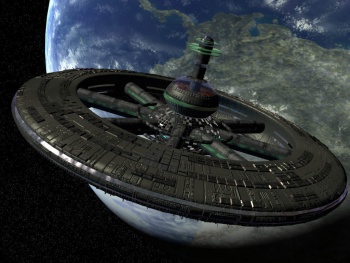Raven's Nest Station
|
The rumored central operation station of the infamous Section 31. Raven's Nest Station or ( RNS ) for short, separated itself from other station designs; A circular disk than offers more weapon hard point than most stations, a critical design adjustment needed to support heavier armament, and 360-degree protection of its core sectioning where the most sensitive operational experiments and observations are undertaken. Only the most basic of details of the station are known outside Section 31 circles. The station was built in secret at the edges of Federation space near the end of President Doenitz reign. It's been rumored that if the Station had been completed earlier that the outcome of the Federation Civil War would have indeed been different. Section 31 inherited the base and used it begin rebuilding the tattered remains of their organization. It is a location that serves as a means to protect its operatives from the ever-increasing hunts for Section 31 operatives. As new technologies were captured by Section 31, the station has been continuously upgraded to keep pace with Section 31's ever-changing needs.
The station is fitted with many experimental systems, which are heavily classified by Section 31. The first being a series of four interlinked Quantum Singularity reactors which supply the base with the power needed to run the many Section 31 experiments that are underway at the station. Next are the Experimental Class IX Impulse Engines which allow the station to travel at sublight speeds thereby allowing for quicker target acquisition. To keep the Station's location safe the RNS is equipped with a Phase Cloaking Device, which allows enemy vessels to approach dangerously close to the station without being alerted to its presence.
The station is protected by a vast array of classified systems. Starting with an ablative, crystalline hybrid hull design that is 55% more efficient at dispersing energy weapon fire along the hull than the standard ablative armor in use aboard starships. Multiphasic regenerative shielding serves as the primary defensive layer. Section 31 prefers this type of shielding due to it's ability to be used in phase space, allowing the station additive stability while in a phased state, and limited protection against any possible threats by phase weaponry. The stations secondary shielding system is a multi-spatial force field. This system, even though rumored to be able to soak more offensive fire power than the main shielding system, is kept in reserve due to the large amount of energy required to power the shield for any significant length of time.
Due to the violent nature of Section 31's mission the RNS has taken precautions to help ensure the protection of their members. The station is home to eight large-scale W.A.R. batteries allowing for devastating and unheard of offensive capabilities all along it's perimeter.
Along with the power of the W.A.R. are fifteen Type XII phaser arrays. Ten of these arrays are placed throughout the outer ring to allow for 360-degree firing arc. An additional five arrays placed along the central core gives the station the ability to maintain heavy fire along multiple firing vectors.
In addition to these measures the station boasts an impressive Point Defensive Pulse Phaser Turret system. These turrets are placed within the two interior defensive rings, with five on each of the upper and lower rings. This placements allow for quick targeting solutions of incoming ordinance and small fighter craft. The main focus of these weapons is to maximize the killing zone immediate to the station's proximity, to protect heavier weapon systems such as the W.A.R., and to keep heavier assault craft at bay and within the targeting area of the W.A.R. drivers. Ten Photon Torpedoes tubes are located on the main ring of the station. While five Quantum Torpedoes tubes help protect the stations core assets.
The RNS is also supported by a small fighter force known as Ravens. The Ravens are phase-cloak capable long-range interceptors that call the station home. Due to Section 31's use of phase cloak technology, the small fighters are very formidable. Their most common method of attack it to approach their target while cloaked, uncloak to attack, and then retreat under cloak in a series of hit-and-run tactics.
The RNS spends the majority of its time in unseen phase. For one month however the Station must decloak to allow the cloaking system to be checked, repaired, and upgraded if need. The cloaking system is under constant watch by the station's Command and Control.
Raven's Nest Station was first seen in the joint USS Rosenante and USS Boudicca Mission : The Raven's Nest
The Raven's Nest was developed by Matthew Locke
